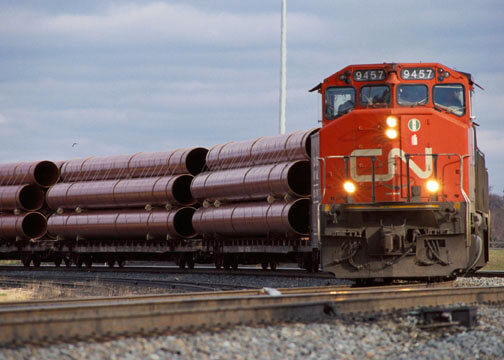
Digitalization of railways drives adoption of connected trains and fleet telematics
by CMO Staff

On-board connectivity and access to online services is set to improve passenger rail traffic and optimize freight management

PHOTO: CN/Canadian National Railway Company
LONDON – The demand for digitalization of rail systems to enhance customer convenience is rapidly increasing across both freight and passenger operations.
Widespread usage of telematics, predictive analysis, sensor technology, and IoT integration has the potential to increase passenger traffic and freight movement, and lead to additional infrastructure construction and rolling stock builds, according to a Frost & Sullivan’s Global Rail Outlook, 2019.
The analysis predicts that digitalization will be one of the major factors driving a 15.2% increase in global passenger traffic and a 19% increase in global freight traffic by 2025.
In Europe, freight operators are retrofitting their large fleets of freight locomotives and wagons with advanced sensor technology and telemetry to track the movement of freight cargo, and also monitor its temperature, humidity, and other factors to help optimize the transport and distribution process.
“Digitalization is set to improve the passenger experience through connectivity solutions such as on-board Wi-Fi, entertainment portals, and mobile networks,” said Guruguhan Nataraj, senior industry analyst, Mobility, at Frost & Sullivan. “These aspects and future potential for upgrades are becoming an integral part of rolling stock production and railway infrastructural projects.”
Current trends and region-specific growth
Electrification of railways is witnessing a global upswing, triggered by the move towards greener rail systems and air quality improvement. Replacement of diesel-powered locomotives with electric or alternative powertrains such as liquefied natural gas (LNG) and hydrogen power is growing in popularity, following the successful operations of hydrogen-powered rail vehicles in Germany. Europe and Asia are leaning towards complete electrification of passenger rail systems.
In North America, sales of high-powered Tier 4 locomotives are projected to improve as a significant number of units are nearing retirement. The European Union, on the other hand, is promoting electrification and greener rail systems, such as hybrid locomotives and hydrogen-powered trains. The Asia-Pacific and Latin American regions are slated to see higher uptake of multiple units, as well as witness growth in rail infrastructure.
“Emerging countries in Asia, Africa, and Latin America should form public-private partnerships with major rolling stock manufacturers to further their plans of electrification,” noted Nataraj. “For instance, India has partnered with Alstom, Siemens, and Bombardier to realize its plan of total electrification of passenger railways.”
Where sectors can leverage the growth:
- Entering public-private partnerships with governments for rail electrification projects.
- Digitalizing trains and railway infrastructure to improve passenger comfort and freight transportation.
- Manufacturing locally to achieve significant cost savings in infrastructure, procurement of raw materials, labour, and operations.
- Developing alternative sources of power for propulsion of rail vehicles, such as hydrogen fuel cell and LNG, to fill non-electrified railway routes which are impractical to electrify.
Global Rail Outlook, 2019, is part of Frost & Sullivan’s Automotive & Transportation research and analyses.